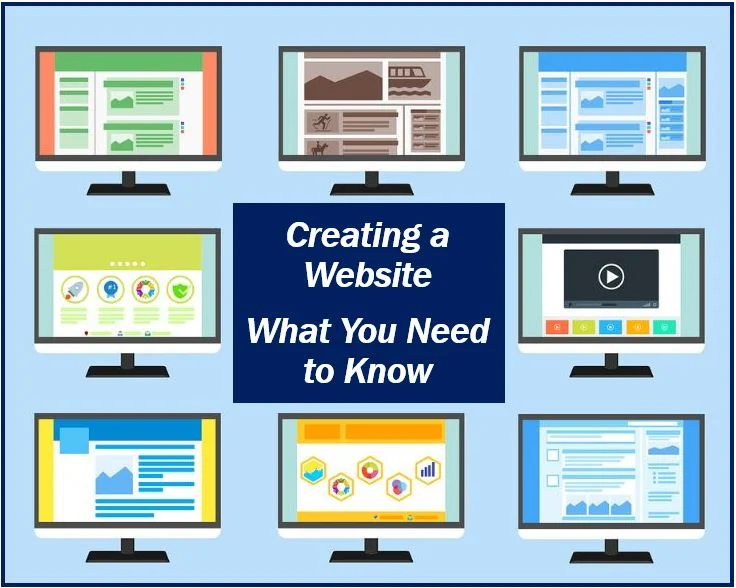The following is a brief introduction to the topic:
Congratulations! Congratulations! You have taken the first steps towards creating your online presence. The journey does not end here. Website creation is only the start of a larger process. You must take the next step to succeed on the digital scene. This comprehensive guide will explore the strategies and techniques that are crucial to maximizing your online presence. We will cover everything from search engine optimization to marketing content. Let’s start this exciting journey!
Understanding the Next Steps is Important
After your website has been launched, you should focus on the next steps. This phase is critical for increasing your visibility, driving traffic, and ultimately reaching your online goals. If you ignore the next steps, your website may get lost in a vast digital landscape. It’s important to be proactive to ensure online success.
The right website builder is crucial to maximizing your presence online. You can create a professional website without any technical knowledge with a reliable website builder. It offers essential tools and features to optimize your site for search engines, customize the design, and integrate different functionalities.

If you are looking for an excellent website builder with a smooth user experience and many features, I highly recommend hocoos.com. Example Website Builder’s intuitive drag-and-drop interface, extensive template library, and powerful search engine optimization capabilities empower users to create stunning websites that are both visually appealing and optimized for search engines. If you are a blogger or an e-commerce entrepreneur and want to build a website for your small business, Example Website Build offers many customizable options.
Create a SEO strategy
Search Engine Optimization plays a crucial role in increasing your website’s visibility through search engines such as Google. You can improve your ranking in the search engine result pages (SERPs), and attract organic traffic, by strategically optimizing for SEO. Here are some key steps you should include in your SEO strategy.
- Keyword Research: Perform thorough keyword research to determine the phrases and terms that your target audience searches for. Focus on long-tail keyword phrases with low competition and moderate search volume.
- On-Page Optimizing: Use relevant keywords to optimize your website’s headings, meta tags, URLs, and content. Make sure your website loads fast, is mobile-friendly and has descriptive alt tags on images.
- Content optimization: Create informative and valuable content that resonates well with your audience. Use H2 headings, subheadings, and your target keyword naturally in your content to increase readability.
- Link Building: Acquire high-quality links from reputable sites to increase your website’s credibility and authority. Reach out to influential people in your industry, create guest posts or infographics others will want to share.
Create High-Quality Content
Content is the foundation of your online presence. Content not only engages with your audience but also establishes your authority and expertise in your field. Here are some tips on how to create high-quality content.
- Understanding Your Audience: Understand your audience by researching their pain points, preferences, and interests. Create content that addresses their concerns and offers solutions.
- Create a Content Calendar. Plan your content ahead of time to ensure consistency and diversity. To stay organized, create a calendar of topics, formats, and publication dates.
- Include Visual Elements. Make your content more visually appealing with images, videos, and infographics. Visual elements increase engagement and help your content be shared more widely.
- Use Attention-Grabbing Headlines: Create headlines that will compel readers to explore your content and click on them. Include your keywords in a natural way to improve SEO.
- Keep your content readable: Use bullet points and subheadings. Your content will be easier to read and skim.
- Include relevant Calls to Action in your content. This will encourage readers to engage with the material. These could be prompts for readers to subscribe, share, or comment on articles.
- Keep your audience interested by regularly publishing new content.
- Optimize your content for SEO. Include relevant keywords while maintaining a natural flow. Meta descriptions and title tags can help you to be more visible on search engines.
Social Media Engagement
Social media platforms are a great way to connect with your audience and expand your online presence. Here are some tips on how to effectively use social media.
- Select the Right Platforms – Identify which social media platforms are most aligned with the demographics and preferences of your target audience. Concentrate your efforts on these platforms to maximize engagement.
- Create a Content Strategie: Create a strategy for social media that includes promotional content, curated posts, and interactive content. Customize your content for each platform and its audience.
- Build a community: Create a sense that you are part of a group by engaging actively with your followers. Answer comments, answer questions, and join relevant conversations.
- Use Visual Content. Visual content is extremely effective on social media. Use videos, infographics, and eye-catching pictures to attract attention.
- Use Influencer Collaborations. Partner with influential people in your field to increase your reach and tap their audience. Collaborations include sponsored content or giveaways. They can also involve co-creating of content.
- Analyze and optimize: Regularly analyze your social media metrics to gain insight into which content performs the best. Adjust your strategy to maximize engagement and reach.
Email Marketing: Harnessing its Power
Email marketing is a powerful way to build relationships with your audience. It can also drive conversions. Here are some ways to harness the power email marketing can have:
- Create a Subscribers List: Use valuable incentives, such as ebooks, exclusive content, or discounts, to encourage visitors and customers to sign up for your email list. Strategically place opt-in forms on your website.
- Segment your audience: You can segment your subscribers based on their demographics, interests, or engagement level. You can then send personalized and targeted emails.
- Create Engaging Email Content: Create relevant and engaging email content for your subscribers that offers value. Use storytelling techniques and visuals that are compelling to grab attention.
- Automate Email Marketing Campaigns: Use email marketing platforms to automate campaigns. Set up welcome messages, nurture sequences, and abandoned cart reminders for your communication.
- Monitor performance: Track key metrics like open rates, conversion rates, and click-through rates. Analyze data to improve your email marketing strategy.
Influencer partnerships: a powerful tool
Influencer partnerships can boost your online presence. How to effectively leverage influencer relationships:
- Find Relevant Influencers – Research and identify influential people who are aligned with your brand, and the audience you want to reach. Find influencers who have a loyal and engaged following.
- Building Relationships: Connect with influencers through their social media posts and comments, as well as sharing their content. By establishing a relationship with influencers before reaching out, you can increase your chances of collaborating.
- Collaboration on Content: Look for ways to collaborate, such as guest blogging, sponsored posts, or social media takeovers. Create content that is valuable to both audiences.
- Track and measure results: Monitor influencer collaborations’ performance by tracking engagements, reach, and conversions. Analyze the impact of your online presence, and adapt your strategy accordingly.
Performance Analysis and Optimization
It’s important to analyze and optimize performance regularly to maximize your online presence. Here are some important steps to take into consideration:
- Implement analytics tools: Use robust analytics software such as Google Analytics for data collection on traffic to your website, user behavior, and conversions. Analyze data to get insights about your audience and pinpoint areas of improvement.
- Set Key Performance Indices (KPIs). Establish KPIs aligned with your online goals. This could include metrics like website traffic, conversion rate, time spent on the page, or social media engagement.
- A/B testing: Run an A/B test on different elements in your website such as headlines or call-to-action buttons. This will optimize your website to improve its performance.
- Monitor SEO Performance – Keep track of the SEO performance of your site by monitoring keywords, backlinks, and organic traffic. Find ways to increase your search engine visibility.
- Keep up with Industry Trends. Stay updated on the latest trends, algorithm updates, and digital marketing best practices. Adapt your strategy accordingly to stay on top of the competition.
Expanding your Online Presence
Consider implementing these strategies to expand your online presence:
- Guest blogging: Submit guest posts on reputable websites within your industry. This will help establish your expertise and expose your brand to a new audience. It also builds valuable backlinks.
- List your website in relevant online directories, review sites, and other platforms. This will improve your online visibility, and help potential customers find you.
- Collaboration with Partners: Create partnerships with complementary businesses and influencers within your industry. To expand your reach, cross-promote content from each other or offer joint promotions.
- Podcasts and Webinars: Participate in podcast interviews or host webinars to share your expertise and knowledge. You will be seen as an expert in your field, and you can reach a larger audience.
- Online Advertising: Run targeted online advertising campaigns such as Pay-per-Click (PPC), social media ads, or pay-per-click ads to increase your brand’s visibility and drive traffic towards your website.
- Local SEO: Optimize your website for local searches if you have an actual physical location. Claim your company on Google My Business. Optimize your listings in local directories and encourage reviews from customers.
- Cross-Platform promotion: Promote your content and website across multiple platforms including social media, newsletters, and online communities. This will help drive traffic and engagement.
- Participate in Online Communities – Join forums, groups, and communities online where your audience is active. Share your valuable insights, respond to questions, and establish yourself as an expert resource.
Mobile Optimization: What is it?
Optimizing your site for mobile devices in today’s mobile world is essential for an improved user experience and higher search engine rankings. Consider these mobile optimization strategies.
- Responsive design: Make sure your website adapts to various screen sizes and devices. This ensures a consistent, user-friendly experience on desktops, mobile devices, and tablets.
- Fast Loading: Optimize the loading speed of your website for mobile devices. To improve performance, compress images, reduce code, and use caching techniques.
- Mobile-Friendly Navigation: Make your site’s navigation easier for mobile users. Use intuitive menus and minimize the clicks to access information. Implement mobile-specific features such as “click-to-call” buttons.
- Thumb-Friendly Interface: Design your website for easy interaction on mobile devices. Make sure that buttons and links have enough space and are large enough to accommodate touch gestures.
- Mobile SEO: Optimize the content and metadata of your website for mobile searches. Search engine ranking factors for mobile devices, like page speed and mobile-friendly design, are important.
- Mobile Testing: Test your website regularly on mobile devices to ensure the best user experience. Fix any problems or inconsistencies.
Ensuring a Seamless Experience
It is important to provide a seamless user experience to retain visitors, encourage engagement, and drive conversions. Here are some important considerations for a smooth experience.
- Easy Navigation: Make your website easy to use. Clear menus, logical hierarchy of pages, and breadcrumb-based navigation will help your visitors find what they are looking for.
- Consistent Branding – Use the same logo, colors, and typography across all your websites. This will help you build trust and recognition with your audience.
- Call to Action (CTA) – Use prominent and persuasive CTAs that guide users in the direction of desired actions such as signing up for your newsletter, making a purchase, or contacting you.
- Optimize page speed: Increase your website’s loading time to improve user satisfaction and reduce bounce rates. Optimize performance by compressing images, minimizing code, and using caching.
- Mobile-Friendly design: Make sure your website is responsive, and that it displays correctly on mobile devices. Consider how the user will experience your website on mobile devices, including font sizes and interactive elements.
- Forms that are streamlined: Make your forms simple and easy to complete. Use autofill to save time by reducing the number of fields required.
- When users submit incorrect or incomplete forms, they should be guided by clear error messages. Help the user understand how to fix the issue.
- Accessibility: Make sure your website is accessible to users with disabilities. Use alt text on images, and caption videos and follow WCAG guidelines.
- Test and optimize: Test different aspects of your site, such as forms, layouts, and navigation to identify improvement areas. Heatmaps and analytics of user behavior can be used to gain insights and optimize based on data.
Embracing Voice Search
As voice assistants and intelligent devices become more popular, it is important to optimize your website for voice searches. Here are a few tips to help you embrace voice search.
- Conversational keywords: Use long-tail keywords to optimize your content. These words should mimic conversational queries and natural language. Answer questions directly and concisely.
- Snippets Featured: You should aim to be included in the featured snippets as they are often used as answers for voice searches. Use bullet points to make lists and use clear headings. Provide concise answers to frequently asked questions.
- Local Voice Search: If your business is local, you should optimize your site for local voice searches. Include location-specific keyword phrases and make sure your business information and address are accurate.
- Mobile optimization: The majority of voice searches are done on mobile devices. Optimize your site for mobile devices and make sure it loads quickly. Voice searches tend to prioritize pages that load quickly.
- Schema Markup – Use schema markup to give search engines structured data about the content you are presenting. This allows search engines to better understand your content and improves the visibility of voice search results.
What to do Next After Website Creation
After your website has been launched, you should focus on optimizing your online presence. You can boost your online presence by implementing SEO strategies, creating quality content, engaging on social media, harnessing email marketing, leveraging the power of influencer partnerships, and continually analyzing and optimizing your performance. Stay up to date with the latest industry trends, and adjust your strategies accordingly. Your website will flourish if you are consistent, dedicated, and take a user-centric perspective.
FAQs (Frequently Answered Questions)
What should I do once I have created a website?
The next step after creating a site is to maximize your online presence. It involves strategies like search engine optimization, creating high-quality material, engaging on social media, harnessing email marketing, and leveraging partnerships with influencers. You can increase your website traffic, engage more users, and reach your online goals by following these steps.
How can I increase my website’s visibility in search engines?
You can improve the search engine visibility of your website by optimizing it for relevant keywords, creating informative and valuable content, obtaining quality backlinks from reliable websites, and making sure your site is technically optimized. You can improve your website’s chance of ranking higher on search engine result pages (SERPs) by following SEO best practices.
What role do social media play in optimizing online presence?
Social media can be a powerful tool to expand your online presence. You can connect with your audience, promote content, and increase brand awareness. You can increase traffic to your site, build relationships with your followers, and grow your reach by engaging on social media platforms that are relevant to your target audience.
What can email marketing do to help me maximize my online presence and brand?
A: Email marketing can be a powerful tool to build relationships with your audience, and increase conversions. You can keep in touch with your subscribers by building an email list, segmenting the audience, and sending valuable and targeted content. This will drive traffic to your site and encourage conversions.
Influencer partnerships: a good way to maximize online presence
Influencer partnerships are a great way to maximize your online presence. You can increase your online presence by collaborating with influencers that have a large and engaged audience. Influencer partnerships may include sponsored content or guest collaborations. They can also involve co-created material that exposes your company to a larger audience.
How important is it to analyze and optimize website performance?
It is important to analyze and optimize your website’s performance to maximize your online presence and achieve continuous improvement. Monitoring key metrics, such as traffic to your website, engagement, conversions, and user behavior can help you identify areas for improvement, make data-driven decisions and refine strategies.
The conclusion of the article is:
The first step to establishing an online presence is creating a website. It’s important to concentrate on the following steps to maximize your online presence. Implementing effective SEO strategies, creating quality content, engaging on social media, harnessing email marketing, leveraging the influencer partnership, and continually analyzing and optimizing your performance will help you strengthen your online presence and attract more visitors. Always stay up-to-date with the latest industry trends and adapt your strategies accordingly. Also, always put your audience first.





